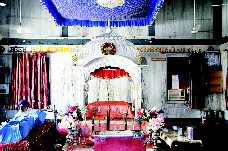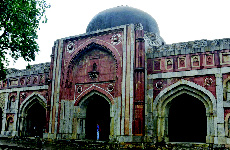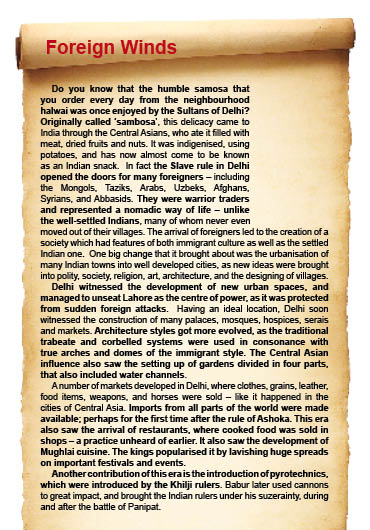If you want to roam in a fort-cum-palace complex that was once the home of one of the most powerful despots in the country, first pay obeisance to a Sufi saint in whose presence even the sultans became commoners; then walk past a boating complex that was once the summer retreat of a British Governor General; and proceed to the Mehrauli Village and the Archaeological Park, where the history of Delhi is unravelled stone by stone.
Many in Gurgaon would have driven past this historical Complex, and even visited the numerous restaurants and designer shops. Friday Gurgaon guides you through this historical maze. Tombs, baolis, forts, and gardens abound in this area – some still whole, some just remnants, and some buried in the natural undergrowth. This Complex, adjacent to the Qutub Minar, remained in obscurity for almost 150 years (after the revolt of 1857); it was only a couple of years ago that it was rediscovered as a living monument to the history of Delhi.
As one enters the Park from the MG Road side, while going to Delhi, it feels as if one is deep inside a jungle of ‘keekar’ trees, and stone monuments that have been conjugated from birth. Beginning at the Tomb of Quli Khan or the Dil-Khusha (Metcalfe House), one soon gets immersed into the vegetation and the history of Delhi.
The British resident to Delhi during the rule of Bahadur Shah Zafar II, Thomas Metcalfe, purchased a large part of what is now known as the Mehrauli Archaeological Park, and landscaped it into a pleasure garden. Metcalfe also got rid of Quli Khan’s cenotaph from the tomb, and converted the area into his weekend retreat. At one point the house, renamed as Dil-khusha, had a drawing room, library, an oratory, as well as external wings for guests and servants.


He also built a boat house, springs, pools, and a couple of canopies and follies, that stand near the Qutub Minar parking. A canopy built by him stands on a mound near the Jamali Kamali mosque. As Metcalfe was the Governor General between 1853-55, his days at the Dilkhusha were shortlived, as the mutineers ransacked this Complex during the revolt of 1857.
Sunil, an avid photographer and history enthusiast, who regularly visits this Park, says that it is unfortunate that this Complex, of immense historical importance, has not been properly revived by the government. “This area lives and breathes history. It could become one of our most important attractions, if proper attention is paid to it,” says Sunil, who also points to the Hindu antecedents of Mehrauli. This area has been built on the remains of a Hindu kingdom, he said, referring to the Chauhans who built the Lal Kot in Mehrauli area.
Another important monument is the Tomb of Balban, who succeeded Razia Sultana, and ruled Delhi with an iron fist. The tomb of Balban was the first to incorporate a true arch, a breakthrough in Indo-Islamic architecture.
The tomb and mosque of Jamali and Kamali belongs to Sheikh Fazallulah (Fazlu), a noted saint and poet, who lived during the reign of the Lodhis, Babur and Humayun. Fazlu was a romantic at heart, and had the arrogance of youth. It is said that he once went to meet his beloved in a deserted spot, and waited restlessly for hours. At last he saw a figure coming towards him through the tree. Thinking that it was his beloved Fazlu grabbed the person; but to his surprise he saw a dervish. Since that night he became a hermit. Fazlu was drawn to the Sufi fold, and acquired ‘supernatural’ powers – becoming popular as Jamal Shah or Jalali Shah. He performed several miracles, and upon the suggestion of his pir, Sheikh Samauddin Fazlullah, he changed his name from Jalali to Jamali. The saint himself began the construction of his own tomb, that is decorated with coloured tiles. The grave next to him is said to be of Kamali, about whom no historical records exist. Tek Chand, an official of the ASI, told Friday Gurgaon, “This tomb is an important part of Delhi’s spiritual history, and sees a lot of visitors. We are trying our best to protect it.”
Even foreigners want the sanctity of this area to be preserved. Galeb, a resident of Saint Petersburg, who comes here often, says that he likes this place for the peace and serenity it offers. Surprising us by speaking in chaste Hindi, Galeb also opines that it is in a way good that not many people come to this place; it helps retains its centuries old charm and character.
Moving further to the right one can see several structures, that include the Gumtis, enclosures and other relics of the past, which are under threat of being erased from the face of the earth, as nature hits at them with vengeance. The scenery also reminds us that kings may come and go, forts may be built, wars lost and won – it is ultimately nature that is all-powerful.
Rajon ki Baoli, literally means the baoli used by the masons. It is believed to have been commissioned by Daulat Khan, a noble, during the reign of Sikandar Lodhi. It is a magnificent three-storeyed step well – that also includes a mosque, and a tomb with twelve pillars. Although dry today, Sunil says that it must have been the centre of life once, particularly during the summers, when people would come here to beat the heat.
Zamuridin, who has a house on the periphery of the Park, says that there is no preservation of monuments in the area. Vijay, another visitor, says that there are a lot of enroachments taking place, and the government has been allowing this to happen. “This will lead to the destruction of this historical Park,” he asserts.
Another important feature is the walled garden of Roz Afzun Nazir, a well known eunuch who served Muhammad Shah in the mid 17th century. An inscription on the western side of the enclosure proclaims, “In the name of God who is merciful and element. In compliance with the order of Muhammad Shah, the just, on whose head rests the holy crown. A flower garden was planted at the Qutub, the flowers of which are praised by the gardener of paradise. May by the blessings of Suras ‘Sad’ and ‘Tabarah’ (from the Koran) Roz Afzun be ever prosperous...”
Further on the ridge is the abode of Kamli Shah, a young lady who had abandoned worldly affairs. She became a mendicant during the reign of Bahadur Shah II, and the Takiya is said to have been built by the king.
Coming out from the Mehrauli Archaeological Park from the left of Rajon Ki Bawli, one comes across the beautifully built Gandhak Ki Baoli, built by Iltutmish, to relieve the area from water shortage. It is said to be the first such step-well in the dry region of Delhi. He is also credited with building the Hauz-i-Shamshi in the Mehrauli area, alongside which exists the Jahaz Mahal – a summer retreat of the Lodhis. These monuments have now been restored to some extent, but still need preservation, as the intrusion of local residents make them more susceptible to wear and tear.
Suddenly, one’s feet start moving automatically in one direction – towards the hospice of Khwaja Bakhtiar Kaki, one of the most influential spiritual saints of the Chishti order. He was the disciple of Khwaja Moinnudin Chisthi. Aminudin Chishti Ghulam Qutubudin Bakhtiar Chisti, whose name literally means servant of the saint, says that universal love, brotherhood and peace was the message of this great saint. “His spiritual teachings focus on renunciation, complete trust in god, and equality of human beiings. Whatever is happening today in Islam, represented by orthodox ideology, is not something preached by Mohd (PBUH),” he says. In this dargah, an equal number of Hindus and Muslims can be seen paying obeisance to the spiritual master.

Just a few hundred metres from this hospice is the famous Banda Bahadur Gurudwara, that represents the great sacrifices made by the Sikhs, particularly under Guru Gobind Singh, while opposing the mindless orthodoxy of the Mughals. Banda Bahadur Singh was a native of Jammu province, who was initiated into Sikhism by Guru Gobind Singh, ransacked the Sirhind Fort and announced the rule of Khalsa there. Jathedar Davinder Singh says that Banda Bahadur was captured in Gurdaspur, along with 740 Sikhs. They were brought to Delhi, and every day a hundred Sikhs were killed in Chandni Chowk. Banda Bahadur was hanged inside a building in Mehrauli for three days, and skinned with hot iron roads. He attained martyrdom. His four year old son, Baba Ajay Singh, was also killed in a gruesome manner.
Ramesh Agarwal, a resident of the nearby street, says that many such stories are lying buried in the streets and walls of Mehrauli. “Cruelty, hatred, passion, revenge, love and spirituality are intertwined in the history of this village,” he says.
Moving from the historical to the living, Mehrauli today is brimming with people from across the country and abroad. An important event that reminds one of this communal brotherhood is the ‘Phool-walon Ki Sair’, an annual event that was started in 1812 by Mumtaz Mahal, the wife of Mughal emperor Bahadur Shah Zafar. It involves a procession led by musicians, dancers, and people bearing floral fans and flowers, to the Yogmaya temple. It winds through the bazars of Mehrauli, and concludes at the Dargah of Khwaja Bakhtiar Kaki. It is said that Mumtaz Mahal had vowed that if her son Mirza Jahangir was released by the British from Allahabad, she would offer a ‘chadar’ of flowers at the Dargah of Kaki. When the Mirza was released she completed her vow, and since then the tradition has continued. The secular Mughal emperor then ordered that a ‘chadar’ should also be offered at the Yogmaya Temple.
The story of Mehrauli would never be complete without visiting the famous Yogmaya Temple, that is dedicated to Goddess Yogmaya, the sister of Krishna. The 5,000 year old temple is attributed with many legends. Just down the road from this Temple is the Qutub Minar and the Quawwatul Islam mosque – that were built within the
Lal Kot area.
The work on Qutub Minar was started by Qutub ud din Aibak but completed in 1220 AD by Iltutmish, and is a standing ovation to the builders, architects, and workers of the time. The mosque, built in 1193, was not only a religious structure, but also symbolised the political authority of the time. It saw the eclipse of Hindu Gurjars and Chauhan rulers.
The Qutub Minar had four monumental gates, but now only the Southern rampart, called the Alai Darwaza, remains. There are several other ruins in this Complex, which are preserved by ASI; they include the Tomb of Iltutmish, the Delhi ruler who preferred to hand over power to his daughter Razia Sultana. It also has Alau Din Khilji’s madrasa, and Imam Zamin’s mosque.
To conclude the Mehrauli archaeological trail one will have to reach the bus terminal. Just opposite to it is the Tomb of Adham Khan, who was thrown from the parapet of the Agra Fort—not once but twice—by Mughal Emperor Akbar, for murdering Atgah Khan in 1566 (husband of another royal nurse). Adham was the son of Maham Anaga, the foster mother of Akbar, and a powerful influence in the court. It was in memory of Adham Khan that this tomb was constructed, and is popularly known as Bhool Bhulaiya. Adham Khan had drawn the wrath of the Mughal emperor, and so was buried in Mehrauli with the slave kings – while Atgah Khan was buried near Nizamuddin. This building was used as a residence by the British resident to the kingdom of Jaipur, and later as a police station. It has presently been restored, and is an attraction for the locals and the tourists.
The history of Delhi, and this nation, definitely owes a lot to the spirit of Mehrauli, that became a home to the Sultans, the Mughals as well as commoners. The area in and around this Village has something special, that has allowed it to cradle empires and become a melting pot of civilizations. Historians say Mehrauli was a laboratory for the rulers of this nation, who used it to mix and match the architecture, the cuisine, the fragrances, and the spirit. An excellent mix it has turned out indeed.
Read More...